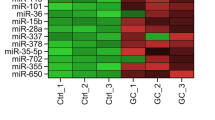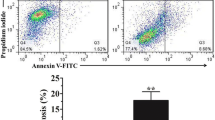Abstract
Sustained dexamethasone (Dex) treatment could induce secondary osteoporosis, osteonecrosis, or even bone fractures. Dex can induce potent cytotoxicity in cultured human osteoblasts. The aim of this study was to test the potential role of microRNA-7 (miR-7), which targets the epidermal growth factor receptor (EGFR), in Dex-treated human osteoblasts. In OB-6, hFOB1.19, and primary human osteoblasts, miR-7 depletion by a lentiviral antagomiR-7 construct (LV-antagomiR-7) increased EGFR expression and downstream Akt activation, protecting cells from Dex-induced viability reduction, cell death, and apoptosis. In contrast, forced overexpression of miR-7 by a lentiviral miR-7 construct (LV-miR-7) inhibited EGFR expression and Akt activation, potentiating Dex-induced cytotoxicity in OB-6, hFOB1.19, and primary human osteoblasts. EGFR is the primary target of miR-7 in human osteoblasts. Luciferase activity of the EGFR 3-untranslated region was enhanced by LV-antagomiR-7, but decreased by LV-miR-7 in OB-6 cells. Further, LV-antagomiR-7-induced osteoblast cytoprotection against Dex was abolished by the EGFR inhibitors AG1478 and PD153035. Moreover, neither LV-antagomiR-7 nor LV-miR-7 was functional in EGFR-KO OB-6 cells. We also show that miR-7 is upregulated in the necrotic femoral head tissues of Dex-administered patients, correlating with EGFR downregulation. Together, we conclude that miR-7 inhibition protects human osteoblasts from Dex via activation of EGFR signaling.




Similar content being viewed by others
References
Schacke H, Docke WD, Asadullah K (2002) Mechanisms involved in the side effects of glucocorticoids. Pharmacol Ther 96:23–43
Ding H, Wang T, Xu D, Cha B, Liu J, Li Y (2015) Dexamethasone-induced apoptosis of osteocytic and osteoblastic cells is mediated by TAK1 activation. Biochem Biophys Res Commun 460:157–163
Yun SI, Yoon HY, Jeong SY, Chung YS (2009) Glucocorticoid induces apoptosis of osteoblast cells through the activation of glycogen synthase kinase 3beta. J Bone Miner Metab 27:140–148
Fan JB, Ruan JW, Liu W, Zhu LQ, Zhu XH, Yi H, Cui SY, Zhao JN, Cui ZM (2016) miR-135b expression downregulates Ppm1e to activate AMPK signaling and protect osteoblastic cells from dexamethasone. Oncotarget 7:70613–70622
Guo S, Chen C, Ji F, Mao L, Xie Y (2017) PP2A catalytic subunit silence by microRNA-429 activates AMPK and protects osteoblastic cells from dexamethasone. Biochem Biophys Res Commun 487:660–665
Zhao S, Mao L, Wang SG, Chen FL, Ji F, Fei HD (2017) microRNA-200a activates Nrf2 signaling to protect osteoblasts from dexamethasone. Oncotarget 8:104867–104876
Liu G, Chen FL, Ji F, Fei HD, Xie Y, Wang SG (2018) microRNA-19a protects osteoblasts from dexamethasone via targeting TSC1. Oncotarget 9:2017–2027
Fan JB, Liu W, Zhu XH, Yuan K, Xu DW, Chen JJ, Cui ZM (2015) EGFR-AKT-mTOR activation mediates epiregulin-induced pleiotropic functions in cultured osteoblasts. Mol Cell Biochem 398:105–113
Fan JB, Liu W, Yuan K, Zhu XH, Xu DW, Chen JJ, Cui ZM (2014) EGFR trans-activation mediates pleiotrophin-induced activation of Akt and Erk in cultured osteoblasts. Biochem Biophys Res Commun 447:425–430
Du H, Guo L, Fang F, Chen D, Sosunov AA, McKhann GM, Yan Y, Wang C, Zhang H, Molkentin JD, Gunn-Moore FJ, Vonsattel JP, Arancio O, Chen JX, Yan SD (2008) Cyclophilin D deficiency attenuates mitochondrial and neuronal perturbation and ameliorates learning and memory in Alzheimer’s disease. Nat Med 14:1097–1105
Huang AL, Ostrowski MC, Berard D, Hager GL (1981) Glucocorticoid regulation of the Ha-MuSV p21 gene conferred by sequences from mouse mammary tumor virus. Cell 27:245–255
Lee KM, Choi EJ, Kim IA (2011) microRNA-7 increases radiosensitivity of human cancer cells with activated EGFR-associated signaling. Radiother Oncol 101:171–176
Xu Y, Li G, Du B, Zhang P, Xiao L, Sirois P, Li K (2011) Hepcidin increases intracellular Ca2+ of osteoblast hFOB1.19 through l-type Ca2+ channels. Regul Pept 172:58–61
Fan JB, Zhang Y, Liu W, Zhu XH, Xu DW, Zhao JN, Cui ZM (2018) Long non-coding RNA MALAT1 protects human osteoblasts from dexamethasone-induced injury via activation of PPM1E-AMPK signaling. Cell Physiol Biochem 51:31–45
Zhang N, Li X, Wu CW, Dong Y, Cai M, Mok MT, Wang H, Chen J, Ng SS, Chen M, Sung JJ, Yu J (2013) microRNA-7 is a novel inhibitor of YY1 contributing to colorectal tumorigenesis. Oncogene 32:5078–5088
Wu X, Liu D, Gao X, Xie F, Tao D, Xiao X, Wang L, Jiang G, Zeng F (2017) Inhibition of BRD4 suppresses cell proliferation and induces apoptosis in renal cell carcinoma. Cell Physiol Biochem 41:1947–1956
Zhu LQ, Zhen YF, Zhang Y, Guo ZX, Dai J, Wang XD (2013) Salinomycin activates AMP-activated protein kinase-dependent autophagy in cultured osteoblastoma cells: a negative regulator against cell apoptosis. PLoS ONE 8:e84175
Kim H, Yang JM, Jin Y, Jheon S, Kim K, Lee CT, Chung JH, Paik JH (2017) microRNA expression profiles and clinicopathological implications in lung adenocarcinoma according to EGFR, KRAS, and ALK status. Oncotarget 8:8484–8498
den Uyl D, Bultink IE, Lems WF (2011) Advances in glucocorticoid-induced osteoporosis. Curr Rheumatol Rep 13:233–240
Weinstein RS (2011) Clinical practice. Glucocorticoid-induced bone disease. N Engl J Med 365:62–70
Kerachian MA, Seguin C, Harvey EJ (2009) Glucocorticoids in osteonecrosis of the femoral head: a new understanding of the mechanisms of action. J Steroid Biochem Mol Biol 114:121–128
Jonas S, Izaurralde E (2015) Towards a molecular understanding of microRNA-mediated gene silencing. Nat Rev Genet 16:421–433
Pasquinelli AE (2012) microRNAs and their targets: recognition, regulation and an emerging reciprocal relationship. Nat Rev Genet 13:271–282
Xu D, Gao Y, Hu N, Wu L, Chen Q (2017) miR-365 ameliorates dexamethasone-induced suppression of osteogenesis in MC3T3-E1 cells by targeting HDAC4. Int J Mol Sci 18:977
Li G, Bu J, Zhu Y, Xiao X, Liang Z, Zhang R (2015) Curcumin improves bone microarchitecture in glucocorticoid-induced secondary osteoporosis mice through the activation of microRNA-365 via regulating MMP-9. Int J Clin Exp Pathol 8:15684–15695
Li H, Li T, Fan J, Li T, Fan L, Wang S, Weng X, Han Q, Zhao RC (2015) miR-216a rescues dexamethasone suppression of osteogenesis, promotes osteoblast differentiation and enhances bone formation, by regulating c-Cbl-mediated PI3 K/AKT pathway. Cell Death Differ 22:1935–1945
Shi C, Qi J, Huang P, Jiang M, Zhou Q, Zhou H, Kang H, Qian N, Yang Q, Guo L, Deng L (2014) microRNA-17/20a inhibits glucocorticoid-induced osteoclast differentiation and function through targeting RANKL expression in osteoblast cells. Bone 68:67–75
Acknowledgements
This work was generously supported by grants from the National Natural Science Foundation of China (81501866), Jiangsu Provincial Young Medical Talent Foundation (QNRC2016411), Jiangsu Six One Project (LGY2018035), Jiangsu 333 Talent Peak Program (To J. F.), and Nantong 226 High-level Talents Project (To J. F.).
Author information
Authors and Affiliations
Corresponding author
Ethics declarations
Conflict of interests
The authors declare no conflict of interest.
Additional information
Publisher's Note
Springer Nature remains neutral with regard to jurisdictional claims in published maps and institutional affiliations.
Rights and permissions
About this article
Cite this article
Fan, Jb., Liu, W., Zhu, Xh. et al. microRNA-7 inhibition protects human osteoblasts from dexamethasone via activation of epidermal growth factor receptor signaling. Mol Cell Biochem 460, 113–121 (2019). https://doi.org/10.1007/s11010-019-03575-y
Received:
Accepted:
Published:
Issue Date:
DOI: https://doi.org/10.1007/s11010-019-03575-y




